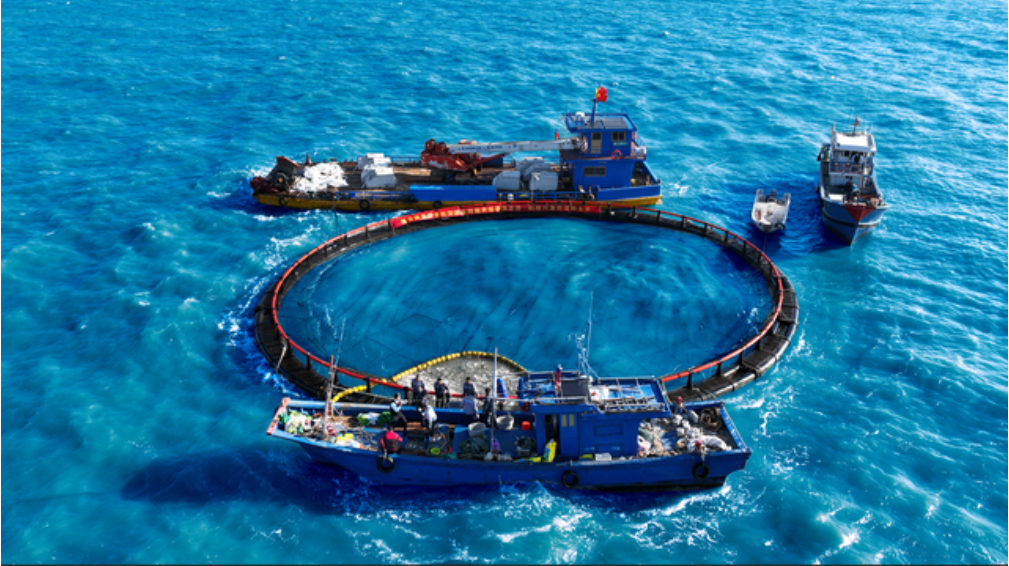
(Picture:Aquaculture platforms off the coast of Shantou, Guangdong)
Guangdong province in southern China boasts the longest coastline on the Chinese mainland. With the second-largest sea area and the third-highest number of islands, it enjoys significant natural advantages for marine development.
As China’s top province in marine economy, Guangdong has held the leading position in total marine output for 30 consecutive years. According to the Guangdong Marine Economy Development Report (2025) released this June, the province’s gross marine product reached 2 trillion yuan (approximately 278.1 billion dollars) in 2024, a nominal year-on-year increase of 5.4%, accounting for 14.1% of Guangdong’s regional GDP and 19.0% of China’s marine GDP.
How to best leverage its marine resources has become a vital question for Guangdong as the country’s leading economic province.
(Picture:Wind farms along the coast of Guangdong)
Marine farming: cultivating food from the ocean
Guangdong has a long history of offshore fishing, the most traditional form of marine economic activity.
In contrast to traditional fishing, high-tech aquaculture facilities in marine ranches have emerged in recent years, boosting seafood production and enriching diets with high-quality protein.
In the waters off Donghai Island in Zhanjiang in Guangdong province, the deep-sea mariculture platform Hengyi No. 1, painted in striking red and yellow, stands like a fortress at sea. It is the province’s largest and smartest mariculture platform, with a total volume of 60,000 cubic meters, designed for species like golden pompano and mangrove red snapper. Each cubic meter of water can yield 10 to 20 kilograms of fish, allowing the platform to cultivate 600,000 to 1.2 million kilograms at a time.
In May, the natural waterbody exchange aquaculture vessel, Bay Area Lingding, was launched in Jiangmen in Guangdong province. It will operate mainly in the Wanshan Archipelago in Zhuhai city, cultivating high-quality species such as golden pompano, mangrove red snapper, and leopard coral grouper, with an expected annual output of 5,000 tons.
This model of offshore farming is referred to in China as the vivid expression “plowing the sea and herding fish”. In 2024, Guangdong’s marine ranching industry generated a total output of 472 billion yuan (approximately 65.5 billion dollars).
(Picture:Mangroves along the coast of Guangdong. Guangdong is the province with the largest area of mangroves in China.)
Marine manufacturing sees rapid growth
In the waters off Yangjiang in Guangdong province, hundreds of white wind turbines rise from the sea, providing green energy for the Guangdong-Hong Kong-Macao Greater Bay Area (GBA). In recent years, Yangjiang has accelerated the development of offshore wind power and is building a wind power base, with a planned capacity of over 10 gigawatts. The combined capacity of completed and under-construction projects has reached 13 gigawatts, the highest in China.
The booming offshore wind power sector reflects Guangdong’s broader push to grow its marine manufacturing industry.
In Huizhou, a coastal industrial cluster integrating petrochemicals and new materials is booming. The Daya Bay of Huizhou, Guangdong province, has attracted 13 Global Fortune 500 chemical companies. ExxonMobil’s 1.6-million-ton ethylene project is operational, and the 47.96-billion-yuan third-phase project of CNOOC and Shell Petrochemicals (CSPC) is under construction, pushing the region into the global top tier of port-based petrochemical manufacturing sector.
Other marine-related manufacturing sectors are also thriving. Zhuhai Yunzhou Intelligence Technology Ltd (Yunzhou-Tech) has developed unmanned surface vessels that have already saved over a dozen lives. According to Zhang Yunfei, President of Yunzhou-Tech, the company was the first in China to industrialize key technologies in the USV sector. Their 40-ton unmanned vessel “Xingzhe” is capable of continuous navigation for thousands of kilometers.
China’s first domestically designed and built deep-ocean drilling vessel, named Mengxiang, or Dream, was commissioned in Guangzhou. Meanwhile, the Zhanjiang Bay Laboratory, home to more than 20 elite research teams, has successfully launched Zhanjiang Bay No.1, the world’s first floating aquaculture platform with dynamic positioning.
(Picture:The intelligent underwater robot designed and produced by Bluedivebot,a Guangdong Company)
Guangdong sets new trend in coastal tourism
While expanding its marine economy, Guangdong also prioritizes the protection of marine ecosystems to ensure sustainable and sound development.
In the Zhelang Peninsula at the Red Bay in Shanwei, a stylish street lined with cafés has become a local attraction. Many visitors relax in lounge chairs with coffee in hand, gazing at the vast blue sea while enjoying their vacation.
According to Liu Dejiang, owner of the café “Looking Singing”, the area used to be an oyster farm that polluted the nearshore waters. In recent years, the local government has improved supporting infrastructure and restored the coastal environment. Abandoned oyster farm shacks have been turned into trendy cafés, attracting a steady stream of visitors. Through such ecological restoration efforts, Guangdong has revitalized its coastal bays and islands.
Developing cruise and yacht tourism has become a key part of Guangdong’s strategy to expand marine tourism and spur new consumer trends. Cities like Guangzhou, Shenzhen, and Zhuhai have developed clusters of yacht clubs and new business models of yacht tourism. Over the past three years, the number of registered yachts in the province has grown by more than 130%. The Nansha International Cruise Homeport is emerging as a new landmark for cruise tourism in the GBA.
(Picture:In Jiangmen, Guangdong, the first batch of catches from the offshore aquaculture platform Taishan No. 1 has achieved a bumper harvest.)
Whether it’s surfing on Nan’ao Island in Shantou, savoring fresh seafood on Hailing Island in Yangjiang, or enjoying low-altitude sightseeing in Shuangyue Bay, Huizhou, Guangdong continues to innovate its coastal tourism offerings.
In 2024, Guangdong’s 14 coastal cities received a combined total of 730 million visitors, up 12.8% year-on-year, generating 950 billion yuan (approximately 132 billion dollars) in total tourism revenue.
Written by Zhao Peng & Xu Yue
Picture by Yang Cheng

